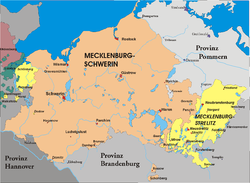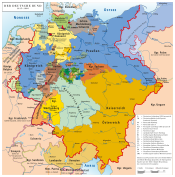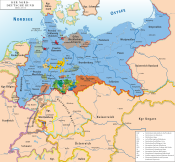
Mecklenburg is a historical region in northern Germany comprising the western and larger part of the federal-state Mecklenburg-Western Pomerania. The largest cities of the region are Rostock, Schwerin, Neubrandenburg, Wismar and Güstrow.

The Duchy of Mecklenburg-Strelitz was a duchy in Northern Germany consisting of the eastern fifth of the historic Mecklenburg region, roughly corresponding with the present-day Mecklenburg-Strelitz district, and the western exclave of the former Bishopric of Ratzeburg in modern Schleswig-Holstein. At the time of its establishment, the duchy bordered on the territory of Swedish Pomerania in the north and of Brandenburg in the south.

Neustrelitz is a town in the Mecklenburgische Seenplatte district in the state of Mecklenburg-Vorpommern, Germany. It is situated on the shore of the Zierker See in the Mecklenburg Lake District. From 1738 until 1918 it was the capital of the Duchy of Mecklenburg-Strelitz. From 1994 until 2011 it was the capital of the district of Mecklenburg-Strelitz.
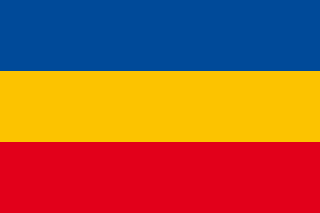
The Duchy of Mecklenburg-Schwerin was a duchy in northern Germany created in 1701, when Frederick William and Adolphus Frederick II divided the Duchy of Mecklenburg between Schwerin and Strelitz. Ruled by the successors of the Nikloting House of Mecklenburg, Mecklenburg-Schwerin remained a state of the Holy Roman Empire along the Baltic Sea littoral between Holstein-Glückstadt and the Duchy of Pomerania.

Princess Augusta of Cambridge was a member of the British royal family, a granddaughter of George III. She married into the Grand Ducal House of Mecklenburg-Strelitz and became Grand Duchess of Mecklenburg-Strelitz.

Adolphus Frederick II, Duke of Mecklenburg, was the first Duke of the Mecklenburg-Strelitz, reigning from 1701 until his death. Mecklenburg-Strelitz was a part of the Holy Roman Empire.
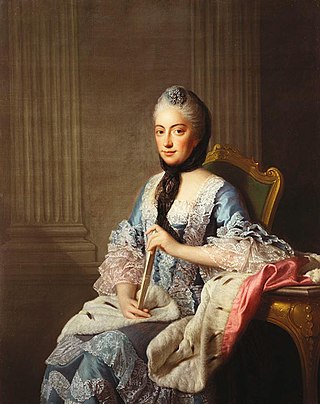
Elisabeth Albertine of Saxe-Hildburghausen was a Duchess of Mecklenburg-Strelitz. She served as regent for her son after the deaths in 1752–1753 of her husband and brother-in-law of, respectively, the ducal appanage of Mirow and of the Duchy of Mecklenburg-Strelitz.

The House of Mecklenburg, also known as Nikloting, is a North German dynasty of Polabian origin that ruled until 1918 in the Mecklenburg region, being among the longest-ruling families of Europe. Queen Juliana of the Netherlands (1909–2004), former Queen of the Netherlands (1948–1980), was an agnatic member of this house.

Charles II was ruler of the state of Mecklenburg-Strelitz from 1794 until his death. Originally ruling as duke, he was raised to the rank of grand duke in 1815. Prior to succeeding to the throne, he served as Governor of Hanover from 1776 to 1786.

Mirow is a town in the district of Mecklenburgische Seenplatte in southern Mecklenburg-Vorpommern, Germany.

The Grand Duchy of Mecklenburg-Schwerin was a territory in Northern Germany held by the House of Mecklenburg residing at Schwerin. It was a sovereign member state of the German Confederation and became a federated state of the North German Confederation and finally of the German Empire in 1871.
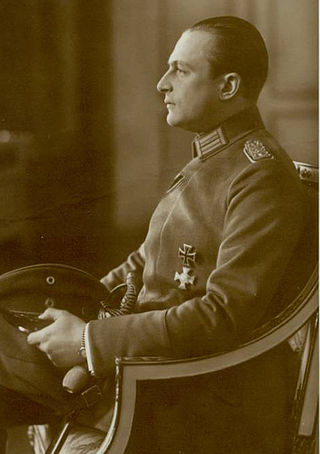
Adolphus Frederick VI was the last reigning grand duke of Mecklenburg-Strelitz.

Adolphus Frederick V was reigning grand duke of Mecklenburg-Strelitz from 1904 to 1914.

George ruled the state of Mecklenburg-Strelitz as Grand Duke of Mecklenburg from 1816 until his death.

Borwin, Duke of Mecklenburg has been the head of the House of Mecklenburg-Strelitz since 1996 and of the entire House of Mecklenburg since 2001. The death of Friedrich Franz, Hereditary Grand Duke of Mecklenburg-Schwerin – his godfather – the last male member of the House of Mecklenburg-Schwerin on 31 July 2001 made Strelitz the only remaining line of the House of Mecklenburg, which ruled in Mecklenburg until 1918.
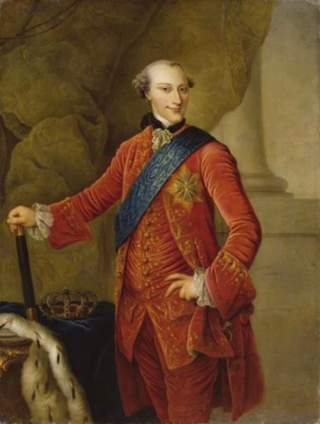
Adolphus Frederick IV was Duke of Mecklenburg-Strelitz from 1752 to his death in 1794.
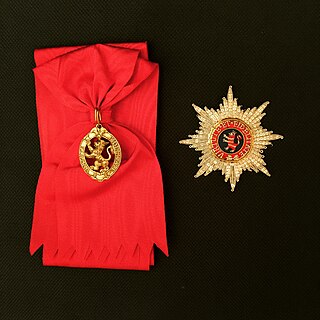
The House Order of the Golden Lion was an order of the German Landgraviate and Electorate of Hesse-Kassel and later, the Grand Duchy of Hesse and by Rhine. It was first instituted in 1770 by Landgrave Frederick II, in honour of and under the patronage of Saint Elizabeth of Hungary, an ancestor of the House of Hesse, and was intended to award auspicious merit.

Duke Charles Louis Frederick of Mecklenburg-Strelitz was a member of the Strelitz branch of the House of Mecklenburg. He was the father to Queen Charlotte of the United Kingdom and Hanover and Duke Adolphus Frederick IV of Mecklenburg-Strelitz.
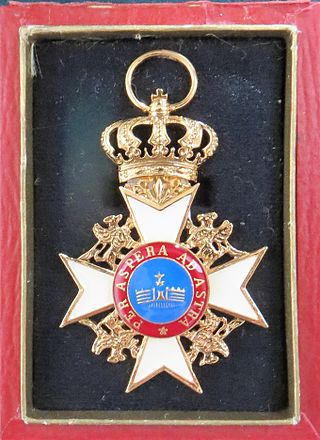
The House Order of the Wendish Crown is a dynastic order that was jointly instituted on 12 May 1864 by Grand Duke Friedrich Franz II of Mecklenburg-Schwerin and Grand Duke Friedrich Wilhelm of Mecklenburg-Strelitz. It is the oldest and most senior order of the House of Mecklenburg.
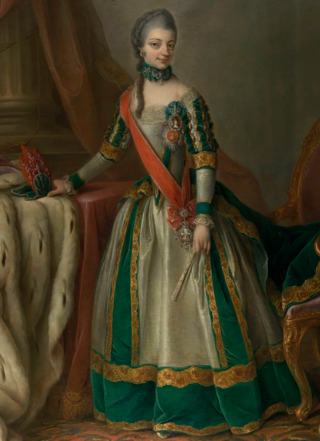
Duchess Christiane Sophie Albertine of Mecklenburg-Strelitz was a granddaughter of Duke Adolphus Frederick II. She was the eldest sister of Charlotte, Queen of the United Kingdom; Adolphus Frederick IV, Duke of Mecklenburg-Strelitz; and Charles II, Grand Duke of Mecklenburg-Strelitz.

